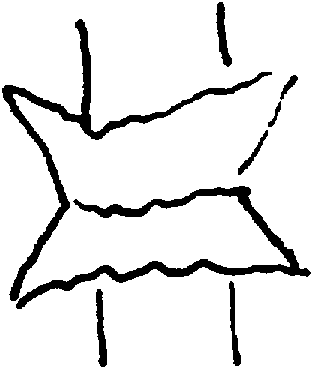
The genus Agaricus, referred to in some hand books as Psalliota, is a very difficult one when it comes to identifying the species. The reference material contained here was taken from a thesis by Bill Forgust Isaacs in 1963 at the University of Washington, titled A Survey of Agaricus of Washington, Oregon and California.
Agaricus is a large and very complex genus and it needs a great deal more research and study, as many sporocarps appear that cannot be identified by our present local literature. The species listed here are the most common for this area, which includes Washington, Oregon, North Idaho and Northern California. This list is by no means complete and will be expanded at a later date.
Agaricus is characterized by chocolate-brown or purple-brown spores, free gills and a cap that is easily separable from the stem. A ring of some sort on the stem is also one of its identifying features. The gills are usually close and their color is described for unopened buttons, and in maturity only when it differs from the normal. Flesh color is pure white or whitish unless noted otherwise. The ring on the stem differs greatly and is often an important feature for identification. If the ring is termed as single, it is thin and membranous, often silky or cottony, and may be left totally or in part as fragments on the cap margin. (There are no universal veil patches on the underside of a single ring.) A double ring is either membranous or firm with veil remnants on its undersurface. It is best seen when sporocarp is young and partially unopened, in the form of thick star-like, tooth edged, or truncate plaques on the under surface of the ring (cog wheel or areolate patched.) An obscurely double ring has slightly developed plaques, but is clearly thickened, especially at the margin, not membranous and tissue thin.
Of the species described here the only one classified as poisonous is Agaricus xanthodermus. However those smelling of phenol or quickly staining yellow should be avoided.
1a Cap without colored fibrils in the button stage
................................................................................2
1b Cap with colored fibrils in the button stage
................................................................................14
2a Size small (cap under 6 cm broad)
................................................................................A. comptulus
CAP 2-6 cm broad, silky white, tinged with golden hue at disc, which cracks slightly with age and turns a darker brown when water soaked (veil remnants on margin). ODOR faint almond. GILLS pure white in unopened buttons, turning to shell pink. STEM 2-4 cm long, 0.35-0.8 cm thick, equal, silky white, bulb usually present at base. RING thin, flaring, often pressed to the stem at maturity. HABIT and HABITAT gregarious, always in grass. REMARKS Edible.
2b Size medium to large
................................................................................3
3a No obvious color change if bruised or cut
................................................................................4
3b Obvious color change if bruised or cut
................................................................................7
4a Cap very large (10-35 cm broad)
................................................................................A. crocodilinus v. crocodilinus
CAP 10-35 cm broad, dry, white or tinged "cinnamon buff" over disc, tips of appressed scales sometimes tinged brownish; flesh cracking into series of overlapping scales, usually on exposure to sun (sometimes the surface remains smooth), firm, thick, unchanged. GILLS many forked at base, light russet-vinaceous in closed buttons, not truly pink at any age. STEM 10-15 cm thick, spindle shaped, (cap hugs ground), white, red-brown with age. RING double, sometimes leaving two distinct rings on stem, lower ring adheres to underside of upper ring and forms large cinnamon buff areolate patches. HABITAT always in the open. REMARKS edible.
4b Size medium
................................................................................5
5a With two rings separated on the stem
................................................................................A. bitorquis
= A. rodmani
 |
CAP 7.7-9.2 cm broad, smooth, dry, white or grayish brown, sometimes with small cracks; flesh solid becoming slightly reddish after cutting. ODOR and TASTE mild. GILLS pinkish with pruinose edges. STEM 3-8.5 cm long, 1.8-2.2 cm thick tapering to blunt point at base; white, dry, slight scabrous scales in bands, above and below ring; stains red at base when cut. RING double, flaring and grooved. HABIT and HABITAT single or in clusters in hard packed soil, spring, summer and fall. REMARKS edible. |
5b With one ring only
................................................................................6
6a Single ring
................................................................................A. campestris
 |
CAP 3-3.5 cm broad, dry, white, smooth with pressed down scales, disc often cracked with age (later dingy tan, disc brown). ODOR mild or burnt almond. GILLS in button bright pink. STEM 3-11 cm long, thick, white sometimes shaded rose, point at base. RING white, single, fragile, thin, evanescent, smells of burnt almonds. HABITAT always in open, grassy places; occurs in spring as well as fall east of the Cascades. REMARKS edible. |
6b Double ring
................................................................................A. integer nom. prov.
 |
CAP 8-11.5 cm broad; white at first, gradually buff to light ochraceous, then pinkish-gray. ODOR slightly unpleasant almond. GILLS white in very young button then grayish pink. STEM 8-11 cm long, 3 cm thick; smooth clavate with slight bulbous base. RING double cogwheel. HABITAT found in open grassy places with moss. |
7a (3b) Staining red or red-brown when bruised or cut
................................................................................A. benesii
CAP 2.5-8 cm broad; (never umbonate) dry, silken, margin floccose-tomentose, white then flushed dingy gray, disc stone color, darkening to maroon. ODOR fungoid. TASTE mild. GILLS pale white to gray-flesh in buttons. STEM 4.5-13 cm long, 0.4-1.7 cm thick, slight clavate base or bulbous; smooth white to pale pink cinnamon at base. RING membranous, flaring, pendant, wooly underside white to pale pink buff. HABITAT conifers, semi-open. REMARKS All parts bruise cherry red. Edible.
7b Staining yellow when bruised or cut
................................................................................8
8a Stain quickly
................................................................................9
8b Stain slowly
................................................................................10
9a Base (2-2.5 cm) subbulbous
................................................................................A. xanthodermus
CAP 9.5-12 cm broad; white, silky, dingy at disc; flesh spongy. ODOR phenolic. GILLS splitting readily, pale whitish at first. RING flaring pendant, buffy color, cotton-floccose under, with inferior overlapping rims, becoming appressed to stem. STEM 7.7-11 cm long, 2-2.5 cm thick, equal, subbulbous in substrata, few loose fibrils at base. MICROSTRUCTURES spores (4.1) 5.0-5.4 (6.4) x (3.0) 3.5-4.4 (4.5) um. REMARKS All parts bruise yellow then slowly to dingy brown. Chrome yellow when cut, especially at base of stem. POISONOUS.
9b Bulbous-thick base (3.3-4 cm), spores large
................................................................................A. albolutescens
CAP 9.5-10.5 cm broad, white, smooth, margin strongly incurved when young. GILLS gray-rose at first. STEM 11-18 cm long, 1.3-2.0 cm thick, slightly floccose below ring; massive flat bulbous base often sunken in substrata, white with yellow base. RING thick, double, wooly patches on underside. HABITAT in duff in dense conifer woods. MICROSTRUCTURES spores (4.8) 6.3-6.5 (7.5) x (3.8) 4.3-4.7 (5.3) um. REMARKS bruises yellow turning to red-brown.
10a (8b) Pointy scales on the stem
................................................................................A. nivescens
 |
CAP 15-25 cm broad, buttons cushion shape, shiny, white then tan; bruise ochraceous; flesh thick, firm, no color change. ODOR almond. GILLS white at first then pale gray, then pale pink-lavender. STEM 8-9 cm long, 1.5-2.5 cm thick; silky white, apex thick; base buff, rounded to flattened, with tiny pointy scales from buff colored mycelium. RING double, lower surface felty ochraceous, to orange patches; flaring then becoming appressed to stem. HABITAT pastures among grasses; fall. REMARKS Edible. A. nivecens var. parkensis grows near trees. |
10b Lacking scales on the stem
................................................................................11
11a Size large (15-20 cm)
................................................................................A. crocodilinus v. mutabilis
CAP 15-20 cm broad, dry surface, small cracks at disc; white to dull tan at disc, bruise bright yellow. ODOR of burnt almonds or wet straw. GILLS tinged wine-pink at first, crowded, pruinose. STEM 10-14 cm long, 3.5-5 cm thick, spindle shaped, white or light flesh color at base. RING flaring out from stem, underside either thick and simple or double, often with truncate tipped branches becoming granular floccose. HABITAT usually pastures or fields. REMARKS edible.
11b Size medium (3-13cm broad)
................................................................................12
12a Ring single
................................................................................A. tenuiannulatus nom. prov.
CAP 3-8cm broad, smooth pale buff, apex cracked with age, scales remaining appressed for life, button cushion shaped; slowly bruising ochraceous; flesh thin, no color change. ODOR slight unpleasant almond. TASTE good. GILLS grayish in button, then gray-brown. STEM 4-7 cm long, 0.7-2.2 cm thick, silky, white, smooth; slowly changes to pale ocher when handled or bruised; slight club at base. RING single, felty, fragile, evanescent. HABITAT lawns, cultivated areas. REMARKS edible.
12b Ring double
................................................................................13
13a Associated with trees (sylvan)
................................................................................A. sylvicola
CAP 5-6 cm broad, smooth, white, silky, stain slowly yellow when bruised; flesh thin white or faintly reddish (particularly in stem). ODOR almond agreeable. GILLS remote, pale, then pinky buff. STEM thin, 6-8 cm long, 0.8-1.5 cm thick, abrupt bulbous base, stout mycelial strands attached, white, sometimes reddish above ring: smooth stains lemon yellow when touched. RING high, large, double, sheathed above, with or without white or yellowish scales. HABIT and HABITAT groups of 2 or 3 in conifer forests; fall, occasionally spring. REMARKS edibility: not recommended.
13b In open pastured, cultivated areas etc.
................................................................................A. arvensis
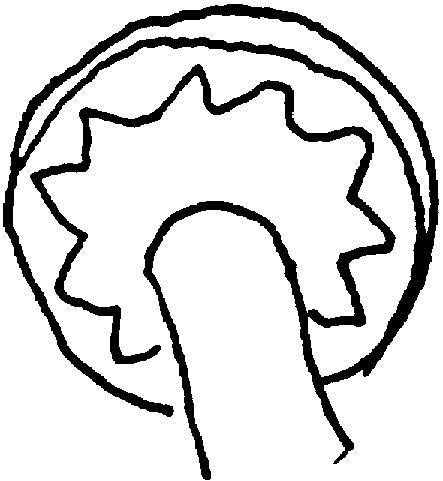 |
CAP 8-14 cm broad, silky slight scaly at disc and margin when mature; white then yellowish ochraceous to cinnamon; flesh of young bruise it stain yellow. ODOR disagreeable, bitter almond. GILLS white soon gray. STEM 7-15 cm long, 1-2.2 cm thick, equal to taper upward, clavate cottony base, tapering to point in ground; white smooth, bruise yellow sometimes. RING double, cog-wheel patches yellowish. REMARKS two forms in NW: 1) mainland - tall slender, thin pliant ring, bruise only if rubbed hard, 2) islands- squat, thick ring, bruise quickly. A. arvensis is edible. |
14a (1b) Size small (under 6 cm)
................................................................................15
14b Size medium to large
................................................................................18
15a Grassy places
................................................................................A. micromegethus
CAP 2-6 cm broad, with truncate disc (no umbo) covered with branch-like patches, pale wine-brown, the rest of the cap pale, streaked from tiny scales, surface bruise yellow. ODOR sweet like anise, later almond. GILLS whitish in button, then rosy, then gray-brown and finally red-brown. STEM 2.5-5 cm long, 0.5-1.0 cm thick, equal or thickened downward, somewhat bulbous, white fibrillose, flushes slowly to ochraceous tawny, bruise bright yellow. RING single, cottony, delicate. REMARKS edible.
15b Conifer woods
................................................................................16
16a Cap with appressed scales; stem with wooly fibrils
................................................................................A. diminutivus
CAP 2.5-3.5 cm broad; not umbonate; dry appressed silky fibrils; disc dark red-brown, buff outward; surface becoming intensely yellow where bruised. GILLS bright rosy pink, then grayish-wine in slightly opened button. STEM 5-6 cm long, 0.4-0.5 cm thick, equal, oval-bulbous base; sparsely floccose often in long patches; bruising and aging yellowish. RING sparsely floccose on underside, white or ivory, apricot orange in age. HABIT and HABITAT gregarious under conifers in leaf mold and needles.
16b Lacking scales of any kind; stem not wooly fibrillose
................................................................................17
17a Cap color deep red-wine at center; not flushing ochraceous
................................................................................A. purpurellus
CAP 4-4.7 cm broad, cushion shaped, convex finally flattened, finely appressed fibrils usually grouped in patches radiating outward, giving streaked silken appearance; margin light grayish, bruising ochraceous. GILLS pale grayish-wine. STEM equal in upper part, rounded bulbous base; pure white, streaked fibrils to slight tufted toward base (bruise like cap). RING single, finely cottony-tomentose. HABITAT open wood in W. Washington, south to N. California. REMARKS edible.
17b Cap color brick-red to rosy-grayish; becoming ocher flushed
................................................................................A. semotus
CAP 3-5 cm broad, pale ochraceous, looks streaked from silky appressed fibrils, rosy grayish at disc and margin. ODOR and TASTE anise-like. GILLS grayish-wine, pruinose. STEM 5-7.5 cm long, 0.5-0.7 cm thick, with clavate base. RING single, flaring and evanescent. HABITAT conifers or mixed forest in needles or leaves. REMARKS edible.
18a (14b) Obvious color change when bruised or cut
................................................................................19
18b No obvious color change when bruised or cut
................................................................................22
19a Staining yellow quickly at stem top when cut
................................................................................A. helodes nom. prov.
CAP 4-15 cm broad, convex, surface smooth at first, then rusty reddish-brown to dark honey-brown, fibrils grouping into overlapping scales over the entire cap except at the brown disc, which is usually cracked. ODOR distinctly phenolic on cutting. TASTE mild almond-like. GILLS grayish pallid at first then light wine-pink. STEM 7-15 cm long, 0.7-1.8 cm thick, white, clavate downward with small grayish bulbous base; discoloring umber-brown with handling, stem top quickly staining yellow when cut. RING flaring, not truly double. HABIT and HABITAT conifers, needle duff, alone or in groups. REMARKS edibility questionable.
19b Staining red-brown when cut
................................................................................20
20a Quickly turning red-brown when cut
................................................................................A. haemorrhoidarius
CAP up to 12 cm, broad, appear smooth at first, breaking into dark brown pointy overlapping scales on near-white ground; flesh thick, firm. GILLS white then gray-pink, pruinose. STEM 7-13 cm long, 1.0-2.1 cm thick, equal, narrow flattened bulb, slightly scaly near base, buff to flesh color below ring. RING simple, large pendant, thin, undersurface buffy not patched. HABITAT in humus under conifers, usually older stands. REMARKS All parts stain cherry-red quickly when cut. Edible and good.
20b Slowly turning red when cut
................................................................................21
21a Cap with small scales
................................................................................A. silvaticus
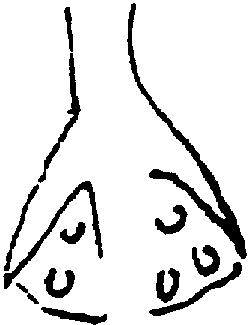 |
CAP 5-15 cm broad, dry, smooth, nut-brown or red-brown scales on lighter ground; flesh firm, thick, rather moist, turning red-brown when cut (especially outer layer at stem top or just above gills). ODOR not special. GILLS whitish then pale pink. STEM 6-10 cm, 1.0-1.2 cm thick, white, smooth, tinged pinky or dingy brown with age, base usually bulbous. RING sheathed, fairly ridged, underside white squamules turning gray at length. HABITAT conifer woods, stem often deeply rooted in needles. REMARKS edible. |
21b Cap with broad scales that have upturned ends
................................................................................A. bisporus
 |
CAP 4.5-7.5 cm broad, dry red-brown or cinnamon-brown scales on flesh color ground. GILLS close to crowded, pallid then rosy pink. STEM 7-10 cm long, 1.1-1.8 cm thick, equal, flat rounded marginate bulb. RING white, narrow, felty, undersurface wide toothed flaps that separate from the surface and point down the stem. HABITAT cultivated or manure rich ground. REMARKS not common in Washington. Edible. |
22a (18b) Size large ( 8-38 cm broad)
................................................................................23
22b Size medium (4-18 cm broad)
................................................................................24
23a Stem not floccose but truly scaly
................................................................................A. augustus
 |
CAP 8-35 cm broad, flat truncate smooth disc, abundant dark brown concentric scales with pointed tips on buff color ground, yellowish when rubbed. GILLS white then flesh. STEM 8-25 cm long, 1-4.5 cm thick, clavate downward, deep in soil, sordid cinnamon-brown when cut, especially base. RING ample, double, thick cottony patches on underside with pointy tips, buffy color. HABITAT in duff under conifers in flower gardens or trash heaps. MICROSTRUCTURES spores mostly 7.7-9.4 x 5.1-6.0 um. REMARKS edible, almond flavor. |
23b Stem with wooly patches in rings
................................................................................A. elwhaensis
 |
CAP 12-35 cm broad, surface very scaly except appressed fibrillose disc, color dark brown, pale whitish ground; flesh thick, just under cuticle stains bright yellow, then orange. ODOR and taste mild almond. GILLS pale then gray-wine. STEM 15 cm long, 2 cm thick., equal above large submarginate bulb, tapering down into a short blunt soil insertion; buff colored wooly scales in rings. RING double, margin flaring, with thick blunt edge, buffy felty cracked patches, especially near margin. HABITAT conifer, needle duff. REMARKS edible. |
24a (22b) Scales on cap some shade of gray
................................................................................A. praeclaresquamosus
= A. meleagris
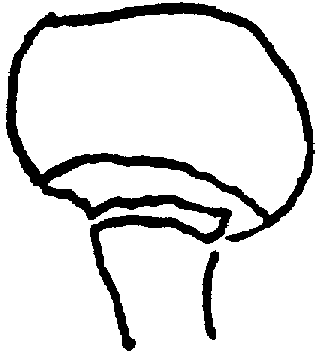 |
CAP 6.5-15 cm broad, rounded with flattened top, silver-gray or gray-brown scales on pale ground; flesh pinkish with age, sometimes first yellowish, sometimes no color change. GILLS pale gray then light pink. STEM 6.5-16 cm long, 0.6-3.2 cm thick, equal or tapering up from slight bulbous base; silky buff color, discoloring pinky-brown, sometimes turning yellow where cut or broken. RING large, flabby, double, cottony patches on underside, tips point down, pull away with age to form second ring. ODOR phenolic. HABIT and HABITAT conifer forest edge, ground or lawn; often in clumps. REMARKS edibility questionable: use caution. |
24b Scales on cap no shade of gray
................................................................................25
25a Scales some shade of lilac, purple, purple-brown or red-brown
................................................................................26
25b Scales some shade of yellow or cinnamon
................................................................................28
26a With two rings separated on the stem
................................................................................A. pattersonae
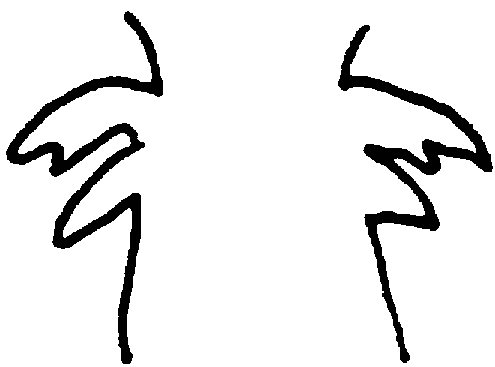 |
CAP 6-14 cm broad, dry, covered with long dark reddish-brown threads which group into patches, ground white, margin fringed. ODOR and TASTE fungoid. GILLS pink. STEM 7-12 cm long, 2-3 cm thick, equal, or slight upward taper, somewhat fibrillose toward bulbous base. RING white, double, flaring, patches on underside near margin, lower ring only slightly flaring. HABITAT under conifers. REMARKS found in California. Edible. |
26b One ring only
................................................................................27
27a Stem with dense patches of white wooly substances
................................................................................A. subrutilescens
CAP 6-15 cm broad, dry rather large lilac to purple-brown scales, in rings, ground color pale whitish, button color sordid red-brown. GILLS white, soon pink. STEM 6-15 cm long, 1.0-1.5 cm thick, slender club shaped to subbulbous base; dense patches of white wooly substance below ring, base slowly discoloring wine-brown. RING flaring, fragile. HABITAT Conifer and mixed hardwood in duff or underbrush. REMARKS edible.
27b Stem smooth
................................................................................A. hondensis
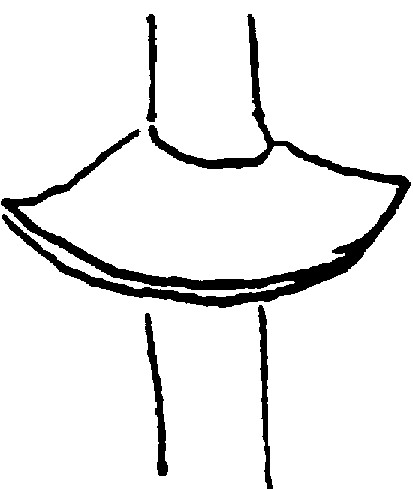 |
CAP 4-15 cm broad, smooth, white with flattened pale fawn-brown or pale lilac-brown scales, dark red-brown in age, margin pale gray to buff. ODOR not special sometimes of creosote. GILLS white, then pink or sometimes lilac-gray, thin and close. STEM 6-15 cm long, 0.5-2.5 cm thick, white, smooth, bulbous base; browning when old or handled. RING flaring (standing out from the stem), felty underside (no patches). HABIT and HABITAT conifer duff, mostly Douglas Fir and Hemlock. Abundant in low elevations, occurring in arcs. REMARKS edibility: not recommended. |
28a (25b) Stem tapering upward (base twice as thick as the apex)
................................................................................A. subrufescens
 |
CAP 8-18 cm broad, silky at first breaking into numerous pressed down, dull tawny-brown scales, with disc red-brown, sometimes cracked. ODOR when crushed, strong of almonds. TASTE of green nuts. GILLS white then pinkish. STEM 7-15 cm long, tapering up to 1-1.5cm at apex; white fibrils toward clavate to abrupt bulbous base. RING large double, cottony, pale tawny scales below. HABITAT cultivated areas, broad leaf trees. REMARKS Small spores (6-7 x 4-5 um) and rounded bulbous base should separate this from A. augustus or A. perrarus. Edible |
28b Stem equal with abrupt bulbous flattened base
................................................................................A. perrarus
CAP 8-15 cm, ochraceous tawny innately fibrillose at first, disc remaining so, in age spotted by appressed scales loosely arranged, ground pale; flesh white, moderately thin. GILLS white to gray-pink. STEM 8-15 cm long, 1.0-1.5 cm thick, equal above abrupt flattened bulb. RING buffy white, underside colored like the cap and torn into floccose patches. HABITAT occurs under spruce and pine. REMARKS Edible. Most modern European authors treat A. perrarus as a synonym or color variant of A. augustus. Some material of A.H. Smith from California under the name A. perrarus has been renamed A. smithii
appressed - flattened down
areolate - marked with cracks or crevices
concentric - having rings or zones
clavate - club shaped
evanescent - slightly developed, soon disappearing
fibril - a minute fiber, thin and threadlike
fibrillose - fibrils arranged more or less parallel to one another, compactly or scattered
floccose - loose cottony or downy-wooly, more or less tufted like cotton flannel
membranous - thin and pliant
ochraceous - between cinnamon-buff and yellow
pruinose - as if finely powdered
scabrous - rough with short rigid projections
tomentose - wooly matted
truncate - large portion ending as if cut off
| SPECIES | KEY ENTRIES |
| AGARICUS L. | |
| A. albolutescens | 9b |
| A. arvensis | 13b |
| A. augustus | 23a |
| A. benesii | 7a |
| A. bisporus | 21b |
| A. bitorquis | 5a |
| = A. rodmani | |
| A. campestris | 6a |
| A. comptulus | 2a |
| A. crocodilinus v. crocodilinus | 4a |
| A. crocodilinus v. mutabilis | 11a |
| A. diminutivus | 16a |
| A. elwhaensis | 23b |
| A. haemorrhoidarius | 20a |
| A. helodes nom. prov | 19a |
| A. hondensis | 27b |
| A. integer nom. prov | 6b |
| A. meleagris (see A. praeclaresquamosus) | |
| A. micromegethus | 15a |
| A. nivescens | 10a |
| A. pattersomae | 26a |
| A. perrarus | 28b |
| A. praeclaresquamosus | 24a |
| = A. meleagris | |
| A. purpurellus | 17a |
| A. rodmani (see A. bitorquis) | |
| A. semotus | 17b |
| A. silvaticus | 21a |
| A. subrufescens | 28a |
| A. subrutilescens | 27a |
| A. sylvicola | 13a |
| A. tenuiannulatus | 12a |
| A. xanthodermus | 9a |
- END -